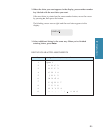
2.8
Sending a Fax
Setting Document Resolution and Contrast
We recommend sending documents printed using a typewriter, felt tip pen,
black ink, or laserwriter. The paper should be white or very light, and of
normal weight - not cardboard. Blue lines on a ruled pad donÕt fax well.
When you send normal documents, you need not adjust the resolution and
the contrast.
If you send documents with unusual contrast characteristics, including
photographs, you can adjust the resolution and contrast to send a high-
quality transmission of the documents.
Resolution
Press the Resolution button to increase sharpness and clarity. Resolution
is preset to Fine at factory, but if you press the Resolution button
repeatedly after loading a document you can switch between Standard,
Fine, and Super Fine modes.
Fine is good for documents containing small characters or thin lines, or
print from a dot-matrix printer. When Fine is selected, the Fine lamp lights.
Super Fine works well for documents containing extremely fine detail.
When Super Fine is selected, the S.Fine lamp lights. Super Fine works only
if the remote machine also has the Super Fine feature.
Contrast
Press the Contrast button to compensate for the brightness or darkness
of your faxed document. By pressing the Contrast button repeatedly after
loading a document, you can choose between Normal, Darken, Lighten, or
Photo.
Darken works with light print or faint pencil markings. When Darken is
selected, the Darken lamp lights.
Lighten works with dark print on a dark background. When Lighten is
selected, the Lighten lamp lights.
Photo is used when faxing photographs or other documents containing
colour or shades of grey. Although your machine wonÕt transmit colour, it
will print and send up to 256 shades of grey. When Photo is selected, both
Darken and Lighten lamps light.
You can set the resolution and contrast home position. The lamp of the
selected mode will light when a document is loaded. For details on how to
set the home position for resolution and contrast, see page 1.13.


















